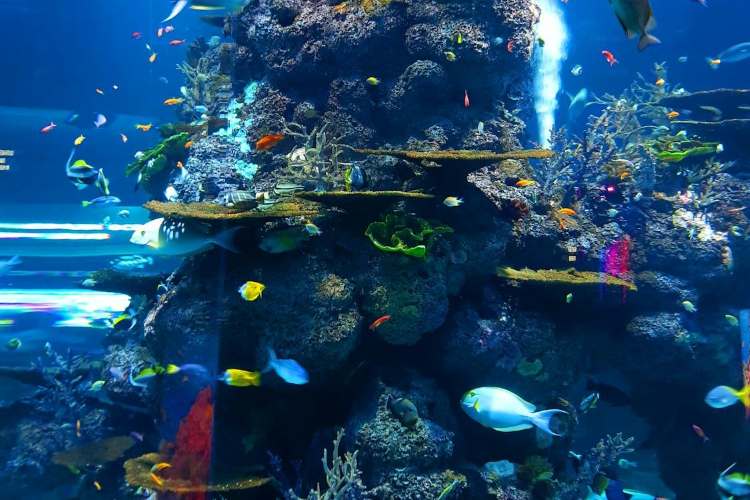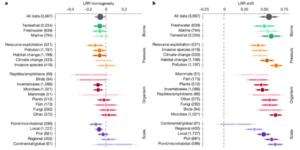
The Earth’s biodiversity is facing a catastrophic decline, and there is no longer room for ambiguity about the culprit. Humans are driving this collapse with devastating consistency across all corners of the planet and across every class of organism. This is the stark conclusion of one of the most comprehensive syntheses of biodiversity research ever undertaken, drawing from over 2,000 studies and nearly 100,000 sites across terrestrial, freshwater, and marine ecosystems.
Published in Nature, the two companion studies — led by researchers from the Swiss Federal Institute of Aquatic Science and Technology (Eawag) and the University of Zurich — shine an unflinching light on the reality of biodiversity loss. They detail not just a reduction in the number of species (local diversity), but also a dramatic shift in community composition — essentially, a reordering of “who lives where.” These changes are driven by five major human pressures: land-use change, direct exploitation of natural resources, pollution, climate change, and invasive species. Each factor alone is potent; together, they amount to an ecological onslaught.
READ I Bitcoin: A mirage of legitimacy and risks for India
The unequivocal impact
Human pressures, particularly habitat degradation and pollution, have slashed local biodiversity by an average of 20% compared to undisturbed ecosystems. Species that are already vulnerable — such as amphibians, reptiles, and mammals — are disproportionately affected due to smaller populations and slower reproduction cycles. Meanwhile, specialised species in fragile environments like high-altitude ecosystems are being replaced by generalists better suited to altered conditions — a process termed the “elevator to extinction,” as these niche organisms have nowhere else to go.

The consequences are far-reaching. These are not just changes in the richness of life on Earth but a reshaping of ecological roles and relationships. As some species vanish or dwindle, others move in to take their place, not always to the ecosystem’s benefit. Pollinators, seed dispersers, and decomposers — essential to agriculture and natural cycles — may decline, threatening food security and ecosystem services.
Destruction of biodiversity
Perhaps one of the more surprising findings of the analysis is that, contrary to popular assumptions, human impact does not always lead to biotic homogenisation — the idea that ecosystems are becoming more similar due to the spread of generalist species. Instead, the studies found a more complex picture. At smaller, local scales, human activities tend to cause biotic differentiation — communities becoming more dissimilar due to random extinctions and ecological drift. At larger scales, however, homogenisation remains a concern, as species are redistributed by human actions such as trade and transport.
Shifts in composition of biological communities

Importantly, the studies quantified changes using three dimensions of biodiversity: local diversity (number of species in a given place), compositional shifts (changes in species makeup), and spatial homogeneity (similarity between different communities). The results are alarming: all five human pressures cause significant shifts in composition, with pollution and habitat change being the most destructive.
Microbes and fungi, though often overlooked, showed the highest shifts in community composition. Their small size and fast reproduction rates allow rapid response to environmental changes — often a signal of ecosystem instability. Meanwhile, large vertebrates — the charismatic face of conservation — suffer the most dramatic drops in local diversity. These losses are closely tied to increased extinction risk, as population sizes fall below sustainable thresholds.
The fallacy of isolated studies
Until now, most biodiversity assessments were limited in scope — either focusing on a single biome, a narrow group of organisms, or a specific pressure. This fragmented understanding has hampered conservation efforts, making it difficult to compare impacts or prioritise strategies globally. The strength of the new synthesis lies in its scale and methodological rigor. By comparing impacted sites with reference controls across thousands of studies, it creates a benchmark that can inform and assess future biodiversity policies and targets.
This integrative approach also reveals the interconnectedness of different dimensions of biodiversity. Sites with greater loss of species also exhibit greater shifts in community composition and increased differentiation. These findings validate long-standing ecological theories — but more importantly, they underscore how loss at one level (e.g., species numbers) cascades into broader ecosystem disruption.
A call to bend the curve
The current trajectory of biodiversity loss presents one of the greatest challenges humanity has ever faced. It is not just about saving iconic species or pristine habitats. Biodiversity underpins the health of the planet — from stabilising climate and purifying water to ensuring food security and disease regulation. As climate change accelerates and global consumption grows, the cumulative impact of human activity threatens to push ecosystems beyond tipping points.
What is urgently needed is a coordinated, global response akin to climate action — and ideally, integrated with it. Land-use planning, pollution control, invasive species management, and sustainable resource extraction must become central pillars of development strategies, not afterthoughts. Conservation targets must be ambitious, enforceable, and based on the best available science. Crucially, we must recognise the value of less visible species — the microbes, fungi, insects — that quietly sustain life.
At the local level, this means creating space for nature within agricultural and urban systems. At the global level, it means reevaluating trade practices, reducing carbon emissions, and increasing funding for biodiversity-rich but economically poor regions.
The findings are sobering, but they are not cause for fatalism. Instead, they provide clarity. The data dispels myths and confirms suspicions: humans are not only altering ecosystems but are doing so in predictable, measurable, and often preventable ways. It is now possible to trace and attribute biodiversity decline to specific pressures, across different species and scales. That knowledge is power — if we choose to use it.
Biodiversity cannot be treated as collateral damage in the pursuit of economic growth. It is the foundation upon which all economies ultimately rest. The window to “bend the curve” of biodiversity loss is rapidly closing. The time for vague commitments and fragmented actions is over. The science has spoken with unprecedented clarity. The question is whether society will listen — and act.
